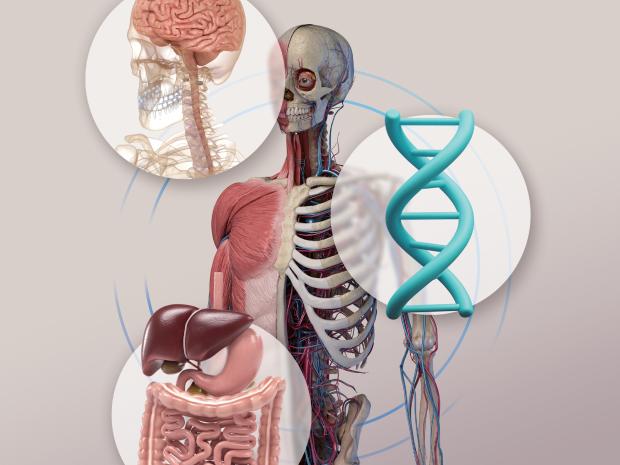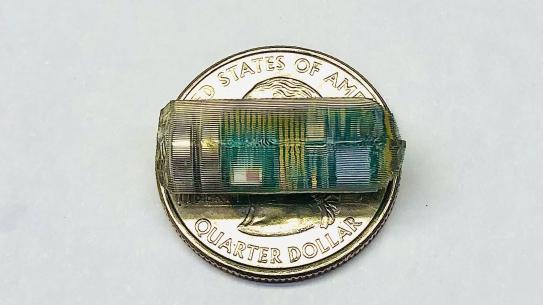The Engineers in the Exam Room

Your Brain on Engineering
The human brain is the most complicated object in the known universe: 171 billion cells, among them 86 billion neurons, arranged in an interconnected electrochemical network that, even after a century and a half of study, still includes untold mysteries. The brain’s ripeness for new discoveries makes it a tantalizing canvas for engineering, and researchers at NYU Tandon are diving in.

Take stress, for example. Rose Faghih, Associate Professor of Biomedical Engineering, has been working for the last seven years on a technology that can measure mental activity using electrodermal activity (EDA) — an electrical phenomenon of the skin that is influenced by brain activity related to emotional status. Internal stresses, whether caused by pain, exhaustion, or a particularly packed schedule, can cause changes in the EDA — changes that are directly correlated to mental states.
The overarching goal — a Multimodal Intelligent Noninvasive brain state Decoder for Wearable AdapTive Closed-loop arcHitectures, or MINDWATCH, as Faghih calls it — would act as a way to monitor a wearer’s mental state, and offer nudges that would help them achieve a more neutral state of mind. For example, if a person was experiencing a particularly severe bout of work-related stress, the MINDWATCH could pick up on it and automatically play some relaxing music.
The broader impact and applications of the methodology include performance monitoring, mental health monitoring, and measuring pain and cognitive stress. Mental health tracking like that enabled by MINDWATCH could pave the way to better management of autism, post-traumatic stress disorders, excessive irritability, suicidal tendency, and more.
While Faghih studies healthy brains in action, Tandon researchers are also setting their sights on diseased or damaged brain states, in the hope of preventing serious injury and ensuring the continued health of individuals.

Working alongside a team at NYU Grossman School of Medicine, researchers led by Junbo Chen, a doctoral candidate in Tandon’s Electrical and Computer Engineering department, developed an AI computer program that processes MRI results and can accurately identify changes in brain structure that result from repeated head injury.
Experts have long known about potential risks of concussion among young athletes, particularly for those who play high-contact sports such as football, hockey, and soccer. Evidence is now mounting that repeated head impacts, even if they at first appear mild, may add up over many years and lead to cognitive loss.
While advanced MRI identifies microscopic changes in brain structure that result from head trauma, researchers say the scans produce vast amounts of data that are difficult to navigate, and the damage is not picked up by other brain scans.
The new tool, using machine learning, accurately distinguishes between the brains of male athletes who played contact sports like football versus noncontact sports like track and field. The results linked repeated head impacts with tiny, structural changes in the brains of contact-sport athletes who had not had a concussion diagnosis — changes so tiny, they would be missed by experienced doctors reading the scans themselves. And as the machine was fed more data, it learned to pick up these changes even more accurately and quickly, making it a potent tool in assessing potential long-term damage from contact sports and other repetitive brain injuries earlier than is possible today.
It Takes Guts
Diarrhea. Constipation. Heartburn. Millions of people suffer from these painfully common conditions and often endure inconvenient and invasive medical procedures to diagnose the causes. That could soon change.

Khalil B. Ramadi, Assistant Professor of Biomedical Engineering at NYU Tandon, has developed a tiny pill-like electromagnetic device that, once swallowed, could provide medical professionals a diagnostic window into the inner workings of the gastrointestinal (GI) tract. The bluetooth-enabled device delivers a continual stream of data to a smartphone as it passes through the subject, using electromagnetic technology similar to what makes Magnetic Resonance Imaging (MRI) machines work.
This breakthrough means that the more than one-third of the global population with irritable bowel syndrome and other disorders related to motility — the functioning of muscles and nerves in the GI tract — could avoid standard diagnostic procedures like computerized tomography (CT) scans, X-rays or endoscopic tubes inserted through the nose or other entry point. Those procedures can be physically and mentally uncomfortable, rely on potentially harmful radiation, and demand patients spend considerable time inside medical facilities.

Instead, the ingestible radiation-free microdevice would require only that people keep close to electromagnetic coils as the device makes its way through their bodies. The coils could be worn in a backpack or jacket, so patients could go about their normal lives during the process.
Ramadi is also working on similar electric pills that can interact with the brain through the brain-gut axis, the network of connections between the two organ systems. It would allow doctors to activate areas of the brain without direct stimulation or surgery, and may open up avenues of treatments for several brain diseases and disorders.
Good Genes

With advancements like CRISPR, genetic engineering is entering its own renaissance. But while most geneticists are focusing on a few thousand base pairs at a time, some researchers — like David Truong, Assistant Professor of Biomedical Engineering at NYU Tandon and Associated Faculty of Pathology at NYU School of Medicine — are thinking bigger. Truong is pushing the boundaries of biomedical engineering when it comes to genetics, building the technology necessary to change not just thousands of base pairs at a time, but millions. And that engineering work could have profound implications for the future of healthcare.
The challenge he’s taking on is human induced Pluripotent Stem Cells (iPSCs), which have the potential to transform from an embryonic state into any type of cell needed. The problem is these cells can be highly personalized — cells harvested from one person might be rejected by another. Truong has created technology to swap out the genetic coding in these cells that personalized them to an individual, and swap in genetic code that matches potential patients.
With these changes, Truong and his team are turning iPSCs into cancer-fighting cells. T-cells, for example, can hunt down tumors, but they are susceptible to the self-defense mechanisms of the tumors themselves, which also involves shutting down the body’s surrounding natural immune system. With this technology, cells can be “trained” to get around those suppression mechanisms and turn the immune system around the tumor back on, recruiting the body’s natural defense system to help defeat the cancerous cells.

Truong is not the only Tandon researcher engineering cells for health solutions. Consider: If you cut yourself, you will probably heal readily, since skin cells have the ability to regenerate. That’s not true, however, of the more than two billion cardiac muscle cells in the human heart, since most of those cells, known as cardiomyocytes, lose the ability to divide soon after we are born. That means that someone who suffers a heart attack, for example, will not grow new cells to replace those that die.

Irene de Lázaro, Assistant Professor of Biomedical Engineering, who runs Tandon’s NanoBioEngineering for Tissue Reprogramming and Regeneration laboratory, is working to change that situation by investigating the mechanisms by which in-vivo reprogrammed cells contribute to regeneration; studying the impact of mechanical and biochemical controlled perturbations on cell plasticity and reprogramming; and engineering reprogramming factor delivery vectors that will allow for efficient, safe, and clinically translatable reprogramming.
A Healing Gel
In June 2023, Cresilon, a Brooklyn-based biotechnology company focused on hemostatic medical device technologies founded by NYU Tandon alum Joe Landolina (BS/MS ‘14), received the first FDA clearance for human use of the technology for its Cresilon Hemostatic Gel™ (CHG). The plant-based hemostatic gel technology rapidly controls bleeding when applied to a wound without the need for manual pressure, which makes it easy to use while working instantaneously to both stop and control bleeding at the point of care. The company’s current product line VETIGEL™ is in use for veterinary care, and the FDA clearance takes Cresilon further toward its future plans to save lives by targeting human trauma and surgical applications. Landolina, named to Forbes’ 2023 “30 under 30” list for healthcare, invented VETIGEL as a 17-year-old undergraduate at Tandon studying biomolecular and chemical engineering, and his strategic leveraging of NYU’s entrepreneurial support resources, including the NYU Entrepreneurial Institute and an entrepreneurial competition at NYU Stern, helped to build the early foundation for Cresilon.

